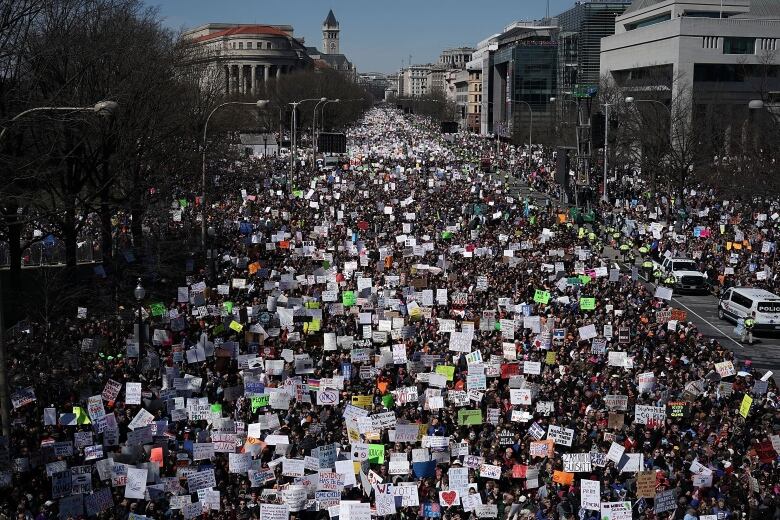'The new norm': High school designed to protect students if there's a mass shooting
'It's just the state of affairs in our country,' says Michigan Supt. Bob Szymoniak

Amid reports indicating shootings are becoming more common at U.S. high schools, Bob Szymoniak says it's time to start designing school infrastructure to maximize the safety of students and staff.
Szymoniak is a school superintendent in west Michigan, where a $48-million US construction project is underway at Fruitport High School. The building is specially designed to make it harder for a potential shooter to get at their targets — and it's a type of school design that architects in other areas of the U.S. are starting to experiment with.
According to the Washington Post, more than 228,000 students have been exposed to gun violence since the Columbine High School shooting in Colorado in 1999.
Classes will begin at Fruitport High School on Sept. 3, but the construction is not expected to be finished until 2021.
Szymoniak spoke with As It Happens guest host Helen Mann about the school's new design. Here is part of their conversation.
Can you walk me through some of the security features that the new Fruitport High School will have?
We curved the hallways, and the reason we did that was to reduce the sight lines if, God forbid, we had an active shooter in the hallway.
We also built "wall wings," we're calling them. These are cement block walls that are perpendicular to the hallway walls that jut out into the hallway about four feet to further reduce the sight lines of an active shooter. And they also provide refuge for students who would be in the hallway.
And these walls are built adjacent to the classroom doors. So if need be, a student behind the wall could get help immediately from within the classroom.
Once the students are in the classroom, there is what we call a "shadow zone" where we have built another wall wing into the classroom that cuts down dramatically the sight line into the classroom.
So if I'm an active shooter and I'm in the hallway, and the students are in that shadow zone and I look into the classroom, I can't tell anybody's there.

What about in terms of locking kids into certain areas?
All of our doors district wide will have access control where we can lock all of the doors with the push of a button from a cellphone.
How did your school district come to the decision to work these features into the new school design?
It was a combination of factors. The architect that we employed has experience in building security design elements into a project like ours.
And so given the nature of our country these days, the number of school shootings that we have, and they just don't seem to stop, it seemed responsible and appropriate for us to factor in as many security elements into the design of the building as we could.
What kinds of conversations are you having with parents about the new design?
We had a team of folks involved in the design and the decisions were made within that team. Since those decisions were made, these security elements have been shared with our parents, and the feedback that I've been getting has been very positive.
Have there been any parents who have resisted or had complaints about this?
Not one.
You also need to understand that these design elements don't look like security design elements. If you didn't know you were looking at a security design element, you would think you were looking at a modern, attractive, functional school.

Have you, though, had any discussions or given any thought to the impact this may have on young people going to school in a building that is specifically designed to protect them from a shooter?
Like I said, if you walk into our building you wouldn't know it was designed to do that.
But will you be having those discussions with students?
Unfortunately, we have to do active shooter training with our students, and so they will learn what those security elements are. But my sense is that they will appreciate the fact that they're there to keep them safe.
You mentioned that the design firm behind this is used to building secure facilities. As I understand it, they also design prisons. Is that right?
That's my understanding, yes.

So have they designed a significant number of schools before this?
They have, but I don't know that they have designed any with the security elements that we have.
I will say that it's not often that new high schools are built, so this is likely unique across the state. But I would imagine that these types of design elements will become the new norm in school construction.
As an educator for, as I understand it, more than 30 years, did it ever occur to you that one day you might be involved in helping build a school designed to protect people from mass shooters?
It's one of the saddest aspects of my career, having to come to terms with that.
But this is not new. Since the Columbine shooting in 1999, school safety and security has been on my mind as it has been the minds of probably every school administrator in America.
How much do you think it might detract from some of the larger issues that teachers and superintendents should be looking at?
I would say that it goes beyond that. Education has changed so much in even the last 10 years that there's a lot of different reasons to be anxious in this line of work.
But we do what we absolutely can to keep our students and staff safe. And they know that. And it's just the state of affairs in our country.
Written by Sarah Jackson and John McGill. Interview produced by Allie Jaynes. Q&A has been edited for length and clarity.